Kitchen Tip: Measuring Flour
How do you measure flour? Dip and sweep? Dip and shake? Check out this kitchen tip on measuring flour to learn why it makes a difference.
How do you measure flour? Do you dip and sweep? Dip and shake? How about spoon and sweep? You may not think it matters how you measure flour, but let me assure you it does.
Far and away, the best method for success to get those cookies to spread perfectly, bread to be soft instead of stiff, cakes to be moist instead of dry, is to weigh your flour (and other ingredients). To do this, you need to either possess weird superhuman powers or possess a kitchen scale. I have a simple kitchen scale (a Salter version that isn’t sold anymore) that I’ve been using for years and it does the job quite well.
You don’t need to pay out a lot of money to get a great, functional kitchen scale.
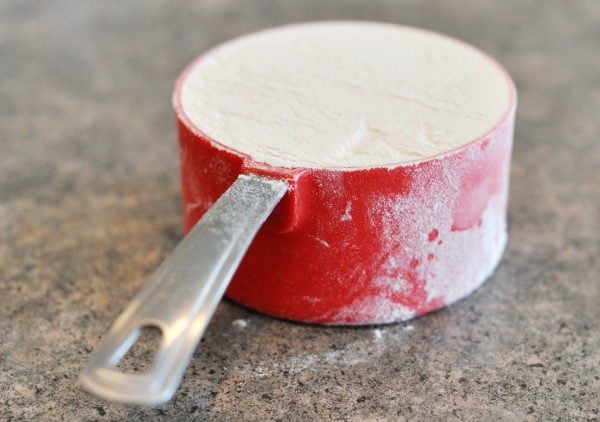
Scales are fantastic if a) you have one and b) the recipe you are using gives you a weight measure along with a cup measure.
However, if you don’t own a kitchen scale and your recipe doesn’t give a weight measure, then the next best thing is to make sure you are measuring flour correctly. That’s why I’m here! I took it upon myself to conduct a little experiment in my kitchen today. I became half scientist just for you.
Follow me.
I weighed a cup of flour using three different techniques:
Dip and Shake
Gently scoop the cup into the flour.
Scoop it deep so the flour is piled high.
Then shake the cup until it is level.
Dip and Sweep
Again, dip the cup into the flour so that it piles high. Don’t slam it into the flour and overpack – just gently scoop the cup through the flour to fill the cup.
And then level it off with a flat edge.
Spoon and Sweep
Spoon the flour into the cup until it is just slightly over the top of the cup.
Level the flour off.
Here are the results:
The Dip and Shake method produced a cup of flour that weighed 6 ounces.
The Dip and Sweep method produced a cup of flour that weighed 5 1/4 ounces.
The Spoon and Sweep method produced a cup of flour that weighed about 4 ounces.
To make the results mean something, here’s the following piece of information – most recipes I’ve seen written with weight measures have a cup of all-purpose flour weighing in at right around 5 ounces, give or take a little (cake flour, bread flour, and whole wheat flour vary in weight but since I used all-purpose flour for my highly scientific experiment today, we’ll dwell on it for now). You can see from the above results that the dip and sweep method came the closest to the 5 ounces a cup of all-purpose flour should weigh.
An ounce or two difference in flour is a huge, and I mean huge, variable in the outcome of baked goods. Cookies with even slightly too much flour won’t flatten but with too little flour, they’ll spread into a pancake. Bread with a tad too much flour can be dry or have issues rising. Cakes with too little flour can sink or flatten and too much flour? Dry again.
So what’s a home chef to do with this information?
Here are my recommendations:
1) If at all possible, invest in a kitchen scale. If a recipe gives you a weight measure. Use it. You’ll get the best results using a kitchen scale whenever possible.
2) For all the recipes that do not have weight measures listed (or if you do not have a kitchen scale), use the Dip and Sweep method (this same method is also recommended by Cook’s Illustrated – I’m so glad they agree with me). It should comfort your flour-measuring soul to know that I always use the dip and sweep method when a recipe doesn’t give a weight – so all of the baked good recipes posted here without a weight measure have been tested, baked and deemed worthy using this flour measuring method. You’ll get the best results on my baked good recipes by dipping and sweeping (and of course, weighing when you can).
As a sidenote: when it comes to yeast doughs, I never use the flour measurement as a hard, fast rule. Instead I go by the feel and look of the dough (you can read more about working with yeast here).
Added Disclaimer: Ok, after the email and comment onslaught, I just have to state this for posterity’s sake – if you use a flour measuring method other than the one I recommended and your baked goods always turn out perfectly, well then, don’t feel pressure to change! This is my recommendation only and I know there are many of you out there who are better bakers than I that may employ the dip-twirl-shake-spoon-level–hula flouring method and it works great every time. Just sayin’ – do what gets you the best results but keep in mind that my very, extremely, highly scientific research (and other creditable sources) point to the dip-and-sweep as a preferred method. Over and out.

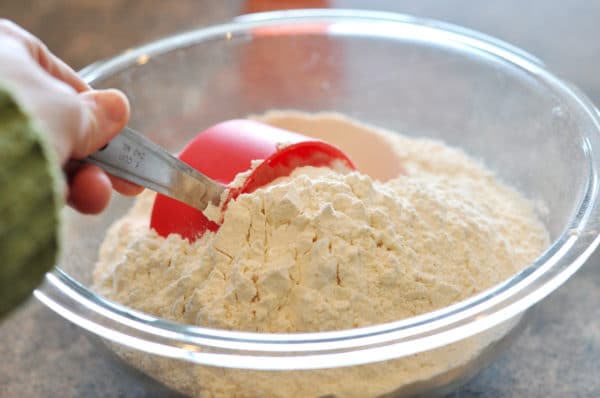
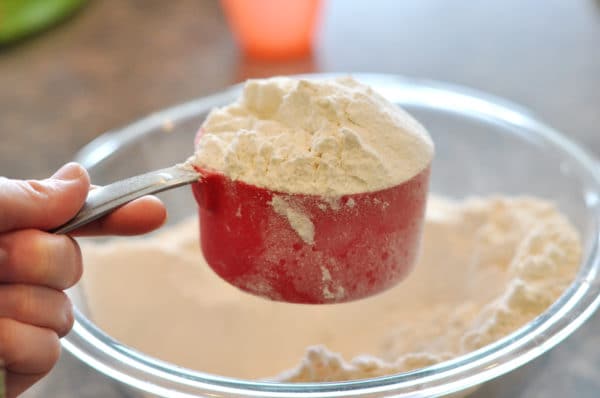
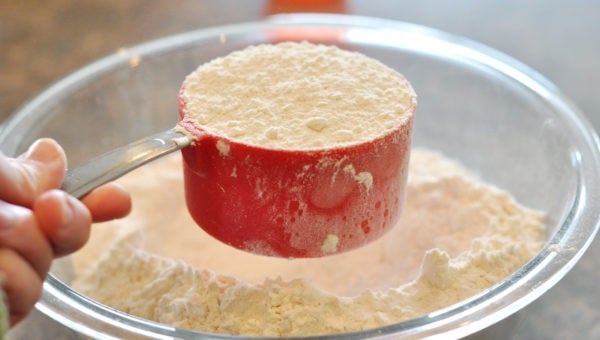
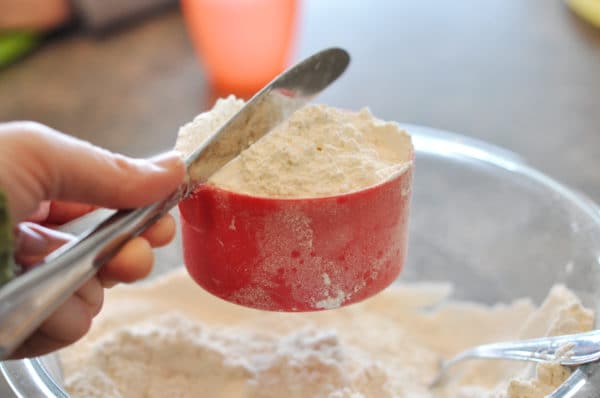
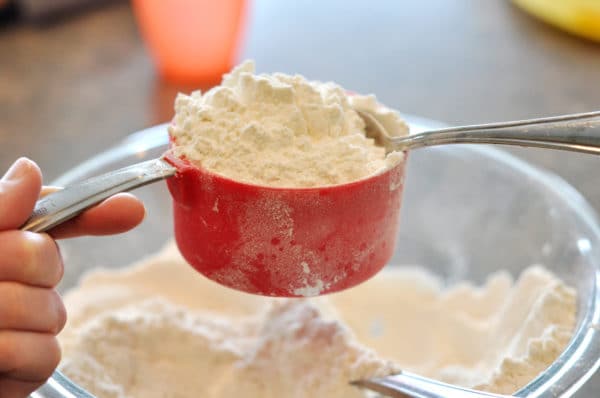
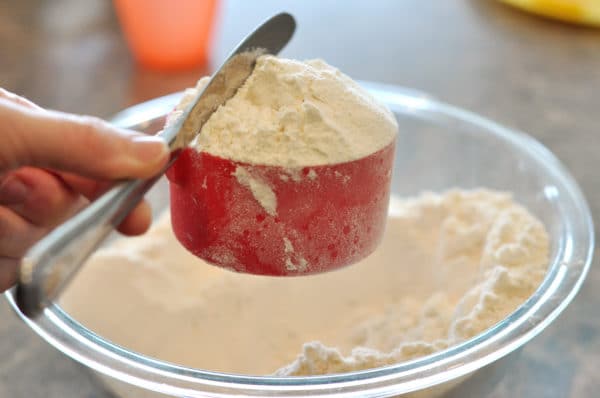
Elys –
The weight of flour varies some from brand to brand. It also varies according to the type of flour; cake flour, for instance, will weigh less than an equal volume of bread flour. That said, the standard for most brands of all-purpose flour (at least here in the USA) is widely considered to be approximately 4 ounces per cup, which translates to about 114 grams. Hope that helps!
Hi Mel,
I’m living in Holland and we don’t usually use cups to measure. Can you tell me how much a cup of flour is in grams. I always weigh my ingredients. When I search the internet on how much a cup of flour weighs in grams I read different numbers. Some say it’s 125 grams while others say it’s 140 grams. I’m confused, so I thought I would ask you. Could you weigh a cup of flour for me and tell me how much it is in grams.
Thanks very much in advance.
Elys – Unfortunately, there is no exact number to give you. The gram value can be anywhere in those ranges depending on how the flour is packed into the measuring cup. Sorry!
Thanks Mel! It’s on it’s ‘weigh’ to me! Man, I crack myself up.
You’re awesome!
I know this is a SUPER old post, but I was wondering if you have a tried and true favorite scale? We’re living in Saudi Arabia now and ALL our ingredients come in ounces, grams, etc. I found a cheap kitchen scale here, but it’s not cutting it.While i can look on Amazon and read a million reviews, I thought I’d check with you first:-). And yes, we can ship almost anything here with our APO address so as long as it’s shippable, I’ll have access to it. Thanks Mel! Years later and you’re still my favorite!
Hi Natalie – wow, Saudi Arabia? You are adventurous! My favorite kitchen scale died a few months ago (ok, my toddler stepped on it). I bought this one from amazon and so far, despite the kind of small weighing platform, I’ve been totally happy with it.
I started weighing ingredients a couple of years ago, and now I cannot imagine going back to doing it the other way! It is so much faster, easier, and produces the same result every time. There’s also the added benefit of dirtying fewer dishes. 🙂 If you’re interested in measuring additional ingredients by weight, King Arthur Flour has put together a fantastic chart of weight conversions for dozens of common ingredients:
http://www.kingarthurflour.com/recipe/master-weight-chart.html
Incidentally, their unbleached all-purpose flour weighs in at 4.25 ounces per cup.
I hate baking! Nothing EVER turns out right. Now I know why. I just read the butter article too. I am now excited to make a batch of chocolate chip cookies.
I’ve always done the scoop/tap-tap-tap/sweep method. Depending on the size of the container you’re dipping from…..the dip/sweep method could result in packed flour and an uneven measure. Maybe it’s just me. Thanks for your recipes…..any other “no chocolate” cookies?? I’m all for chocolate chips!! But when you want something lighter….like the lemon crinkles….it’s nice to have a solid recipe to go to. Thanks
As a UK baker I always translate ‘cups’ and ‘spoons’ into grams or oz’s. Thats just the way I’ve been bought up. Weighing is just in my heritage 😉
I am not an owner of a kitchen scale, but could definitely see one in my future. So I have a novice question: When you weigh, do you leave the flour in the measuring cup? I’m sure not all measuring cups weigh in equally. Thanks for the clarification!
Hi Jennifer – most kitchen scales come with a “tare function” which allows you to put a bowl on the scale, zero out the scale and then add the flour so you are just weighing the flour and not the bowl. Make sense?
Been reading the comments here about dip and sweep vs. scoop and sweep. A few years ago I changed from dipping to scooping as recommended by King Arthur Flour and quite a few other sources.
Today I made your delicious carrot cake and was confused by the measurement of 2 1/2 cups flour and the weight 12 1/2 oz, because under the scoop and sweep method It takes quite a bit more flour to reach 12 1/2 oz. Anyway, I thought perhaps there was a missprint in the recipe and decided it was probably better to go with 2 1/2 cups rather than 12 1/2 oz. The cake turned out great in spite of less flour, but maybe it would have been even greater if I had used the extra flour. Thanks for the recipe, I will be making it again with 12 1/2 oz flour.
I just found your wonderful website. How do you have time to do all of this?
For 40 years I did the dip and sweep and my goodies all came out great (once I passed the newly wed stage). Then one day I read I was doing it all wrong. According to the article I should have been scooping the flour into my cup then leveling it off, so I did that the next few times I baked. The same great taste was there, but the same great texture, and appetizing appearance was not. Thanks to your article I realized I had not all of a sudden become the worlds worst baker. I’m going back to dipping and sweeping. Thank you.
So interesting. I was taught in both my college culinary arts class and food science class that the correct way is to spoon and sweep. But I always end up needing more in most recipes…. Guess that is why! It would be nice to move universally to a weight system so you don’t have to try to guess which method a recipe originated from.
Hi. So do you sift your flour prior to dip and sweep?
Cassandra – nope. I don’t sift unless the recipe indicates (and even then, I’m a lazy sifter). I usually fluff up the flour a bit and then simply dip and sweep.
Hey Mel…any recommendations on a kitchen scale?
Mel, Great post! Once I bought a kitchen scale, I was hooked on weighing my flour! I sure wish more recipes gave weight measurements 🙂 Do you usually weigh your flour or use Dip & Sweep? If you weigh, how many ounces per cup do you use? I use King Arthur all-purpose flour and go by their weight chart of 4.25 ounces per cup. I’d love to hear what your standard is, that way I’ll get the same delicious results!
Wow–I never realized methods of measuring flour varied that much. This was a super helpful post..I need to start using my scale more! Thanks!
Wow such a good tip! I never knew that the slightest diffence in flour weights could make such a big difference. I will definitely always be doing the dip and sweep method! Thanks for the great tip!
Oh some peoples… I love the post and it is great info! I have always spoon fluffed in container, spoon shake over cup and then level off…ahahaha. Now you have a new way to test 😉
My home ec teacher in junior high was fanatical about the dip and sweep method, so I’ve always done it that way.
What a great lesson!
Thanks for sharing!! >.<
hehehe, loved your end note! I do have my own preferred method of actually pouring and sweeping, but now I know it’s OK to dip I’ll do that b/c it’s easier. Or just weigh out 5 oz of flour so I don’t have to dirty a measuring cup! woot!
I have a flour scoop, so I scoop and sweep. Now I’m wondering how that compares to your three methods…
I’ve done all three! Currently I spoon and sweep, but I’m obviously going back to the scoop and sweep now!
Note: I commented earlier but don’t see it now. I’m hoping I don’t appear twice!
Good to know that I’ve been doing it right this whole time. Phew.
I’m a devoted dip and sweeper myself….glad to know I’m on the right track!
I am dying over your added disclaimer. Ohhhhh…. so funny. Other people, not you. Well, you’re funny too. Just not THAT kind of funny!
I spoon and sweep–my 7th grade home ec teacher taught us that. How interesting!
So glad you posted this because almost every single time I’m trying to measure out flour, I think to myself that I know I am doing it wrong!
Ps..I wrote a review on your fajitas…they were awesome! I’m trying the brown sugar spiced pork tenderloin tonight! I’ve never made one before, so I hope it turns out good 🙂
Thanks for your scientific experiment. I always “spoon and sweep.” You learn something everyday and I’m glad I check-in your blog everyday if not a few times a day. From now on I’ll be a “dip and sweep” girl. By the way, do you fluff the flour before you dip? Thanks.
You are a perfect scientist! I love it! I really need to get a scale….but at least I’m going to change my ways. No more dipping and shaking! Thanks Mel!
I’ve always been a “Spoon and Sweep” kind of girl, but after your scientific research, I’ll definitely try the “Dip and Sweep” method. It might just be why my cookies never turn out right! And I trust your research…I’ve never made anything from your blog that I didn’t like, and I’ve made LOTS of stuff. (The fruit salad from last week is in my fridge as we speak!)
I’m a dipper and shaker. I never took cooking in school because I was not domestic at all. Since I married and had children I have become really domestic and actually enjoy cooking. Thanks for the lesson!
Emily – for bread, I don’t worry as much about the requirement in the recipe and I base the amount of flour I use on the look and feel of the dough. Having said that, yes, humidity, temperature, altitude – all of those things can make a difference in how much flour your bread needs.
Question time! I almost always dip and shake, and in my bread recipes, I often actually need more flour than they call for, which I’ve always found weird, and no doubly so since apparently I’m already using lots of extra flour. I’m wondering if it has to do with where I live? I’m in the seattle area and I’ve heard that humidity can affect breads a lot. Thanks!
britt-marie – I don’t weigh my ingredients unless the recipe specifies a certain weight and the reason is because even among tested, tested, tested recipes, the weight of a cup of flour can range anywhere from 4 to 6 ounces (although the standard is closer to 5). Because of that variable, I’d rather use the dip-and-sweep and cut my losses versus trying to figure out if the recipe meant a cup of flour to weigh 4 1/2 ounces or 5 1/4 ounces. Know what I mean? Even though many recipes don’t include weight measures, I also get great use out of my scale because I weigh out meat portions, bread loaves, etc.
I’m so glad you took the time to do this and share your findings w/ us. I’ve started shaking instead of sweeping (even though I was taught that way) and have actually wondered how much difference it was making.
So since you have a scale do you weigh your flour (4 oz) when it says 1 cup? Or do you just scoop?
This is great information to know! I usually dip and shake, but after seeing your results with the scale, I’ll start using the dip and sweep method…unless I win a scale, of course! 🙂
I recently bought a kitchen scale, and I love it! I always spill dry ingredients when trying to scoop them out of the storage canister or the bag. With the scale, I can just measure out what I need into a bowl without any mess.
I like to dip and sweep, so glad to know that is the approved method!
I wish more recipes had weight measurements, because I want to use my scale more often. 🙂
Awesome, I am a long time dipper and sweeper (got it from my mom, who got it from her mom). I never bought into that spoon and sweep method 😉
Hi Gramps! Thanks for weighing in on this issue (pun intended). Using a scale is the best way for the reason you just indicated – each recipe source/expert may use a slightly different weight for their cup of all-purpose flour. It’s great you’ve found a way to work around the issue!
Karen – if a recipe calls for “two cups sifted flour” then my recommendation is to sift flour onto waxed paper and measure out two cups from the sifted flour. Other recipes will say “two cups flour, sifted” – if it says that, you can measure out two cups, sift it, and use it in the recipe. Hope that helps!
I’m a dipper and sweeper, LOL.
My Home Ec teacher would be proud that I remembered what I was taught many moons ago.
This is really interesting, Melanie~ I have always been a spoon and sweep kind of girl, but it will actually be faster (and cleaner) to just dip and sweep from now on. Unless I win that scale! Thanks! Jeanette
The dip & sweep method is what I was taught in Home Economics class. I’ve always done it that way.
Where I get confused is when a recipe calls for 2 cups sifted flour. Do you sift and measure… or measure and sift? I always sift and measure, but I’m not sure that’s correct, either.
Who knew baking was so darned complicated? LOL
I use a scale but in reading several sources I find that most books use 4.5 ounces as the amount for all-purpose flour—and even that varies slightly. Other flours—other weights
If a recipe only gives us cups—I use the 4.5 ounces as my guide
I appreciate your blog
gramps
Ive always been a dip and sweeper. It is the perfect balance for me between laziness (not wanting to “take the time” to actually get out a spoon and then spoon, spoon, spoon the flour into the cup,) and my streak of perfectionism (having a perfectly leveled, make-sure-there-is-no-extra cup of flour).
I’m glad you did this experiment, because the laziness probably would have won out and I never would have done this for myself 🙂
interesting post…….I recently purchased a kitchen scale at the thrifty and wondered if I would ever use it. Now I guess I will.
Thank you for the information! I’ve just barely jumped on the “scale” bandwagon but it’s good to have a tip for those recipes without weight.
I’ve also found that my cookies can either become not flat or too flat if I don’t get the butter softness right on.
I am glad you shared this information. I love to learn new techniques about cooking and baking. Thanks for sharing.
This is really interesting. I actually have a kitchen scale sitting in my Amazon basket because I know I need to start weighing my ingredients. This has me even more convinced.